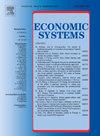使用MIDAS-QR方法进行混合频率的风险增长:来自中国的证据
IF 2.8
2区 经济学
Q1 ECONOMICS
引用次数: 0
摘要
高频金融指标能提供更多有用信息,并能有效预测低频 GDP。为此,我们对传统的风险增长(GaR)框架进行了扩展,使其适用于混合频率数据。在这一扩展中,月度金融指标被用来预测季度 GDP,采用的是混合数据抽样-方差回归(MIDAS-QR)方法。我们利用中国的实证研究了该方法对 GaR 进行高频监测的能力。结果表明,我们的混合频率 GaR 具有良好的预测和现时预测效果,并能对 GDP 下滑进行预警。本文章由计算机程序翻译,如有差异,请以英文原文为准。
Mixed-frequency Growth-at-Risk with the MIDAS-QR method: Evidence from China
High-frequency financial indicators provide more useful information and are efficient at forecasting low-frequency GDP. To this end, we extend the traditional Growth-at-Risk (GaR) framework for mixed frequency data. In this extension, monthly financial indicators are used to forecast quarterly GDP with the mixed data sampling-quantile regression (MIDAS-QR) method. Its ability for high-frequency monitoring of GaR is investigated using Chinese evidence. The evidence shows that our mixed-frequency GaR is promising in terms of good forecasting and nowcasting results, and can offer early warning of GDP downturns.
求助全文
通过发布文献求助,成功后即可免费获取论文全文。
去求助
来源期刊

Economic Systems
ECONOMICS-
CiteScore
4.90
自引率
0.00%
发文量
83
审稿时长
48 days
期刊介绍:
Economic Systems is a refereed journal for the analysis of causes and consequences of the significant institutional variety prevailing among developed, developing, and emerging economies, as well as attempts at and proposals for their reform. The journal is open to micro and macro contributions, theoretical as well as empirical, the latter to analyze related topics against the background of country or region-specific experiences. In this respect, Economic Systems retains its long standing interest in the emerging economies of Central and Eastern Europe and other former transition economies, but also encourages contributions that cover any part of the world, including Asia, Latin America, the Middle East, or Africa.
 求助内容:
求助内容: 应助结果提醒方式:
应助结果提醒方式:


